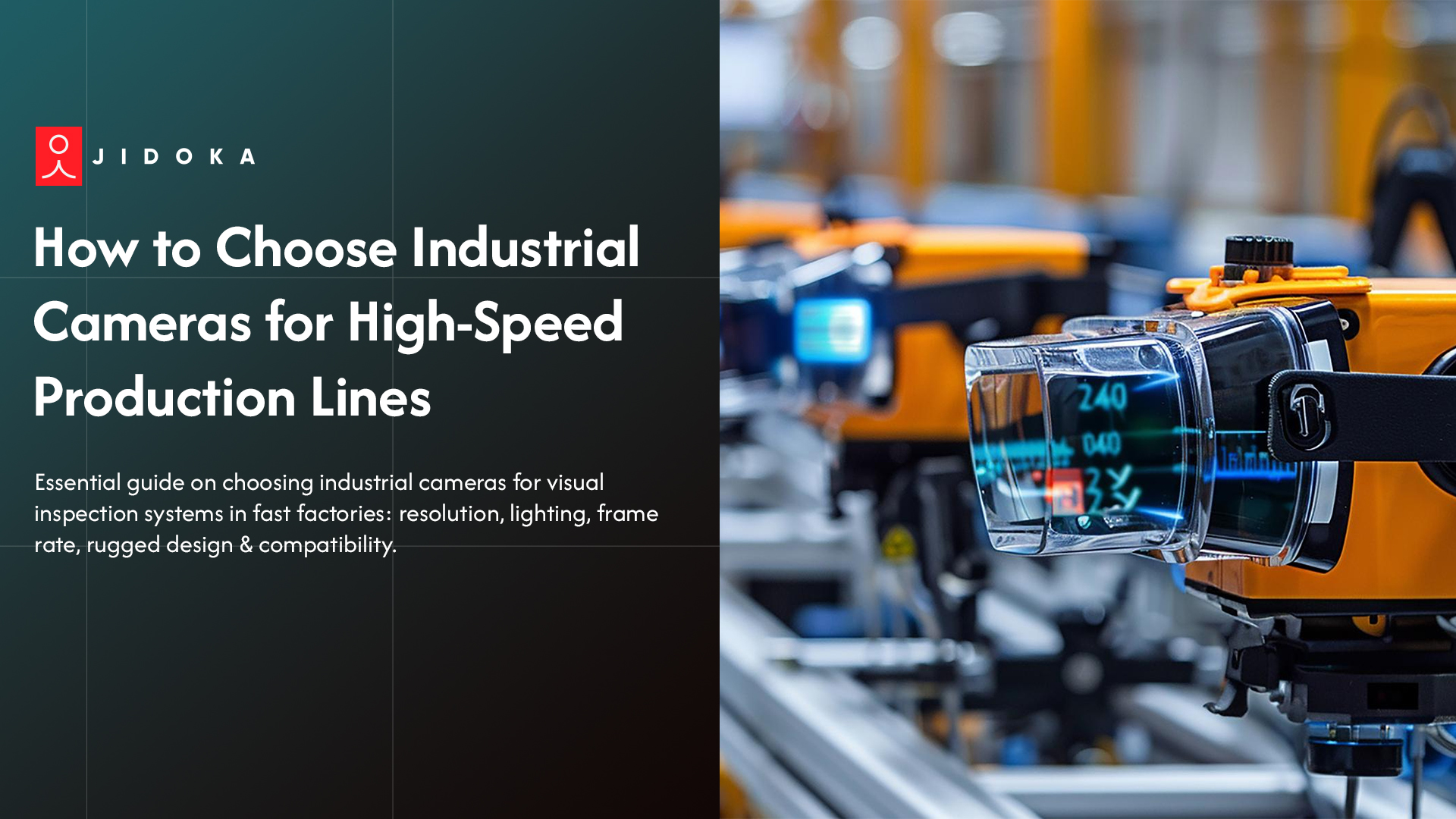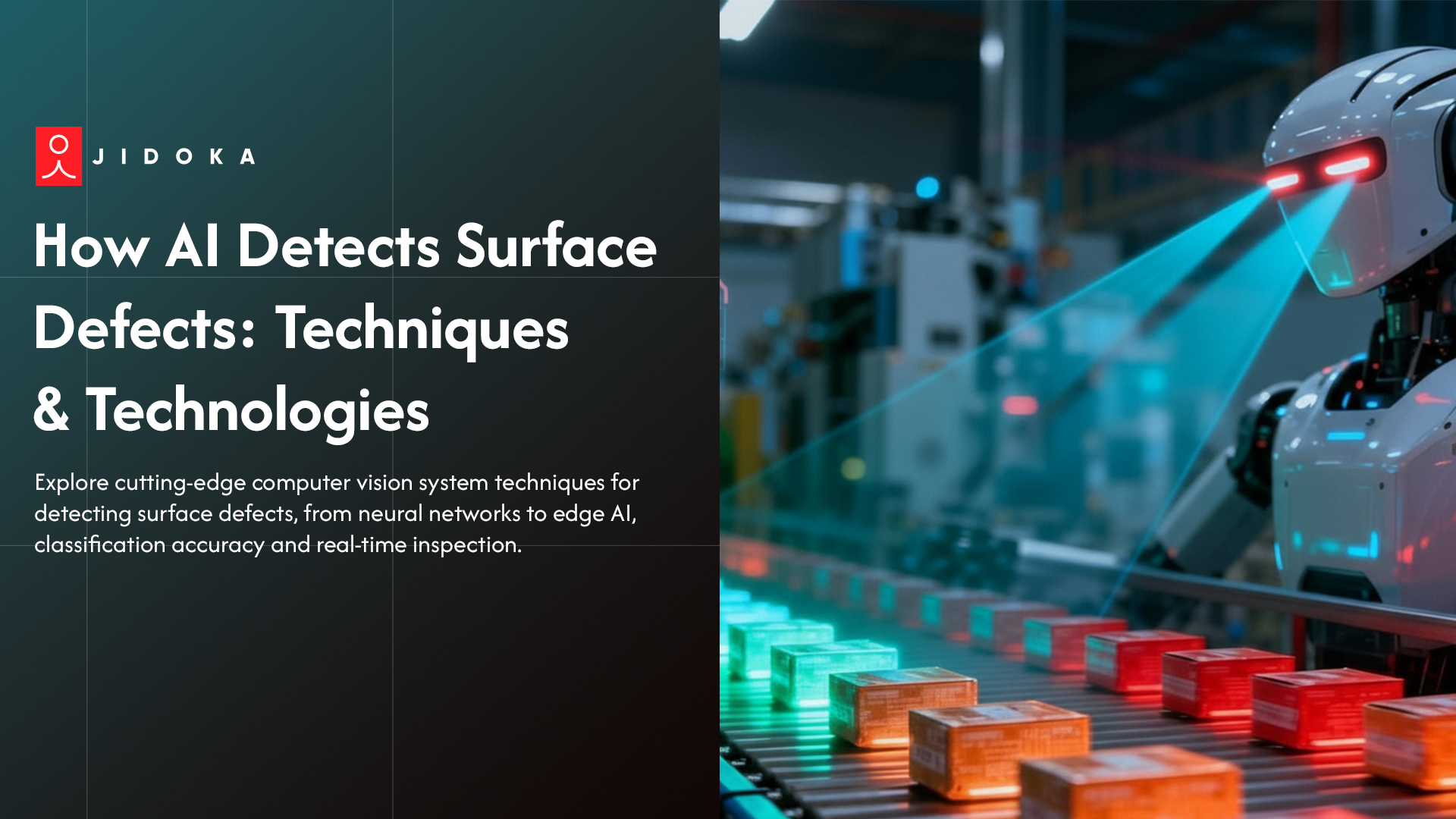U.S. manufacturing demands more than "almost perfect" quality. The machine vision software market is growing fast, projected over $15.8 billion for 2025. This isn't just about cameras. It's about the software's intelligence.
New data shows AI in manufacturing improves defect detection to over 90% accuracy. It also cuts false positives by 30%, so your line only stops for real issues. Many plants still use traditional machine vision.
This post explains the difference between old, rule-based machine vision software and the new, smart AI inspection suite platforms from companies like Jidoka Tech that are defining the future of quality control automation.
What is Traditional Machine Vision Software?
Traditional machine vision is the original workhorse in industrial automation. This older machine vision software operates on a strict, "if-then" logic programmed by an engineer.
1. How it Works: A World of "If-Then" Logic
This system relies entirely on rule-based inspection. A vision engineer must manually program all the rules, like "check for a pixel brighter than X" or "measure this edge." This machine vision software only knows exactly what you tell it to look for. It is a very basic form of defect detection software, but it can only find known problems it's been pre-programmed to see.
2. The Pros: Extremely fast and reliable
So, what is it good for?
This type of machine vision software excels in specific, stable environments.
- It offers extremely high-speed processing for fast production lines.
- It provides unmatched precision for simple, repetitive tasks.
- It is perfect for high-accuracy gauging, alignment, and measurement.
- It is highly reliable as long as the part and environment are perfectly consistent.
3. The "Glass Jaw": Why It Fails
This system is brittle. Any normal variation, like a slight change in lighting or material texture, breaks the rules. This causes a false failure or a missed defect. It cannot handle "high-mix" production lines without an expert reprogramming the entire machine vision software.
This rigidity is why manufacturers now need a smarter, more flexible solution.
The Game Changer: AI-Driven Machine Vision Software
AI-driven machine vision software flips the script. It works like a "smart student" that learns from experience, not a rigid rule-setter. This modern approach to visual inspection is far more flexible and powerful.
This new machine vision software is defining the next generation of quality control automation.
1. How it Works: "Example-Based" Deep Learning
This approach uses deep learning. You don't program rules for this machine vision software. Instead, you use example-based inspection.
You feed the system 50-100 sample images of "good" parts and "bad" parts.
The neural networks inside the software study these examples and teach themselves to identify what "good" actually looks like. This is a core part of a modern AI inspection suite.
2. The "Human-Like" Advantage
This system provides a "human-like" advantage for visual inspection. It can identify complex, subjective defects that are almost impossible to define with "if-then" rules. Think of cosmetic scratches, subtle texture flaws, or slight discoloration.
A traditional machine vision software would fail here, but the AI model learns to see these issues just like a trained human operator would.
3. A Revolution for Defect Detection Software
This is a revolution for defect detection software. The AI can tell the difference between a harmless reflection (a "pseudo-defect") and a critical crack. This dramatically reduces false positives. This capability, often called anomaly detection, means the machine vision software only flags real problems, not harmless variations.
This new approach creates a clear divide in performance.
Head-to-Head: AI vs. Traditional Machine Vision Software
Let's put them side-by-side. The right choice depends on your application, but the trend for industrial automation is clear. The winner is often decided by flexibility and total cost.
1. Deployment & Setup Speed
Traditional machine vision software is fast to set up for simple tasks. An engineer can program rules for a simple "presence/absence" check quickly. But for a complex part, it can take an expert weeks to write and fine-tune all the rules. An AI model, however, can be trained by a quality technician on new, complex parts in just hours or days.
2. Flexibility & Adaptability
This is AI's biggest win. When a new product or packaging is introduced, traditional machine vision fails. You must pay an expert to rewrite thousands of lines of code, causing serious downtime.
With an AI inspection suite, you simply train the machine vision software on the new examples. This makes it perfect for modern high-mix manufacturing.
3. Handling False Positives
Traditional systems are notorious for high false-positive rates. They stop the line for harmless reflections or light changes. AI-powered machine vision software understands "normal" variation. By learning what's acceptable, it stops the line far less often, boosting your real throughput.
4. Total Cost of Ownership (TCO)
Traditional machine vision software may have a lower initial cost. Its maintenance and re-programming costs are very high. An AI inspection suite has a higher initial training cost but a much lower TCO.
Let's look at a 2-year cost example for a factory that introduces 4 new product models per year.
A) Traditional Machine Vision TCO Example:
- Year 1 Initial Cost: $15,000 (Software + Simple Setup)
- Year 1 Re-programming: $20,000 (4 new products x $5,000 expert time)
- Year 2 Re-programming: $20,000
- 2-Year Total: $55,000
B) AI-Driven Machine Vision Software TCO Example:
- Year 1 Initial Cost: $30,000 (Software + Initial Model Training)
- Year 1 Re-programming: $4,000 (4 new products x $1,000 in-house training time)
- Year 2 Re-programming: $4,000
- 2-Year Total: $38,000
In this example, the machine vision software powered by AI saves $17,000 over two years by eliminating the need for expert re-programming.
The high TCO of old systems is pushing manufacturers to find a better way to integrate AI.
How Jidoka Tech Can Help You Bridge the Gap with an AI Inspection Suite
The switch to AI doesn't have to mean ripping out your entire line. This is where an advanced AI inspection suite like the one from Jidoka Tech comes in. They help you bridge the gap by adding intelligence to your existing industrial automation setup.
Here is what makes their AI inspection suite stand out:
- Hardware-Agnostic Integration: You don't need to rip out your existing hardware. The "KOMPASS" machine vision software is designed to be hardware-agnostic. It integrates with your current cameras (like Cognex, Keyence, or Basler) to add a powerful AI brain, saving you from a costly overhaul.
- "Digital Twin" Analytics: A true AI inspection suite must do more than just pass or fail parts. This machine vision software creates a "digital twin" of every inspection. This gives your team the data to perform root cause analysis and spot process trends before they become major problems.
- Faster ROI with Pre-Trained Models: You can deploy this defect detection software in days, not months. The platform includes pre-trained models for specific industries. This means you get a faster setup and can start seeing a return on investment, often in as little as 8-12 months.
Upgrading your visual inspection doesn't have to be a complete tear-down. If you are ready to add powerful AI in manufacturing to your existing line, contact Jidoka Tech to request a demo of the KOMPASS platform.
Conclusion
AI-driven machine vision software is the clear future for quality control. However, many AI in manufacturing projects fail. They often require huge datasets or specialized data scientists, creating a massive barrier to entry.
Choosing the wrong AI inspection suite is a costly mistake. You risk high false positives that stop your line, or a system that becomes obsolete with your next product change, wasting your entire investment.
This is why Jidoka Tech’s KOMPASS platform is a better approach. It's a hardware-agnostic machine vision software that upgrades your existing cameras (like Cognex or Keyence).
Schedule a demo of Jidoka's KOMPASS platform to see how pre-trained models can solve your visual inspection challenges in days.
FAQs
1. What is the main difference between AI and traditional machine vision?
Traditional machine vision relies on rigid rule-based inspection programmed by an engineer. In contrast, AI-driven machine vision software uses deep learning and neural networks. This AI inspection suite learns from example-based inspection (good/bad parts) to find complex, unpredictable defects, making it superior for visual inspection in smart factories.
2. Is AI machine vision software slower than traditional software?
No. The AI inference (the decision) is incredibly fast, on par with high-speed industrial automation. While the initial deep learning training for the AI inspection suite takes time, it's much faster to deploy this machine vision software on new, complex parts than writing new rule-based inspection code.
3. What is a "false positive" in machine vision?
A false positive is when machine vision software incorrectly flags a good part as "bad." This is common in traditional machine vision using rule-based inspection, which sees a harmless reflection as a defect. A modern AI inspection suite uses deep learning to understand normal variations and prevent this costly error.
4. Do I need to replace all my cameras to use AI inspection?
Not necessarily. Many modern AI inspection suite platforms are "hardware-agnostic." This means this advanced machine vision software can run on your existing industrial cameras. You simply add an AI brain to your current visual inspection hardware, saving significant cost on your AI in manufacturing upgrade.
5. Can AI find cosmetic defects that rules-based systems miss?
Yes. This is a key strength of AI in manufacturing. AI-driven machine vision software excels at anomaly detection for subjective flaws like light scratches or texture issues. Traditional machine vision using rule-based inspection cannot define these cosmetic defects, but example-based inspection with deep learning can find them easily.
6. What is an "AI inspection suite"?
It's more than just defect detection software. An AI inspection suite is a complete machine vision software platform for smart factories. It includes the deep learning AI model, user-friendly training tools, and analytics dashboards. It powers quality control automation by finding defects and helping you analyze their root cause.
%20AI-Driven%20Machine%20Vision%20Software_%20How%20is%20it%20Different%20From%20Traditional%20Systems_.jpg)







